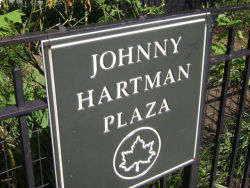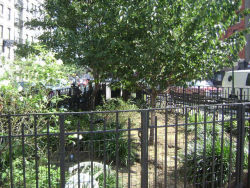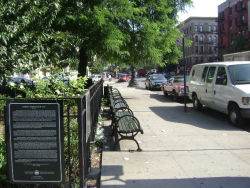Johnny Hartman Square
Johnny Hartman Plaza
This park is named for Johnny Hartman (1923-1983), a distinguished vocalist who is best remembered for his recordings of romantic ballads. This parcel of land was acquired by condemnation by the City of New York in 1876 and includes a portion of the adjacent Hamilton Place. In 1912, the parcel was transferred to the Parks Department. The parkland was originally called Hamilton Square, to honor Alexander Hamilton (1757-1804), once a resident of the neighborhood that has become known as Hamilton Heights. Hamilton was a founding father and one of America’s most influential statesmen for his articulation of Federalist principles. The square was renamed Johnny Hartman Plaza in 1984.
Born and raised in Chicago, John Maurice Hartman began studying voice and piano at the age of eight, sang in his church choir and for his high school glee club, and won a scholarship to study voice at the Chicago Musical College. After serving in the army in World War II, Hartman returned home where he won an amateur singing contest which led him into a professional singing career, working with pianist and bandleader Earl “Fatha” Hines. In 1949, when Hines’ band folded, Hartman was recruited to sing with jazz trumpeter Dizzy Gillespie; their collaboration was memorable because of the contrast between Gillespie’s ‘hot’ trumpet playing and Hartman’s smooth ‘cool’ baritone voice. Hartman sang briefly with the pianist Errol Garner and his trio.
Hartman’s attachment to the love ballad set him apart from other musical traditions of the time like bebop, and he tried to develop a solo career with some difficulty. As a serious vocalist who was trained in both classical and contemporary genres, he still could not overcome the prejudices of the 1950s when clubs had fixed ideas about who could sign what; Hartman would lament the times he was prevented from entry unless he ‘sang the gutbucket blues’.
His career jumped in 1963 when he recorded with avant-garde saxophonist John Coltrane. The unlikely collaboration between Hartman’s more traditional vocal serenade and Coltrane’s far-reaching melodies was a huge success. Between 1947 and 1961 Hartman recorded eight albums, but his 1963 recording John Coltrane & Johnny Hartman was considered one of his greatest. The recording established Hartman as a jazz singer, despite his classical training and broad repertoire.
Hartman continued to record to the end of his life. In 1981, he was nominated for a Grammy for his album Once in Every Life. His last album, This One’s for Tedi, was dedicated to his wife Theodora.
The gnarled Black Locust trees that adorn Johnny Hartman Plaza were planted in the early years of Robert Moses’ tenure as parks commissioner, in the mid-1930s. The Black Locust is widely admired for its fragrant and beautiful flowers and is one of the most commonly planted ornamental trees in Europe and America.
NYC Parks, community resident groups, and the Hamilton Heights West Harlem Community Preservation Organization continue to maintain and beautify Johnny Hartman Plaza.
There’s nothing you can do with a good song but sing it.
— Johnny Hartman
Check out your park's Vital Signs
Clean & Safe
Green & Resilient
Empowered & Engaged Users
Share your feedback or learn more about how this park is part of a
Vital Park System



